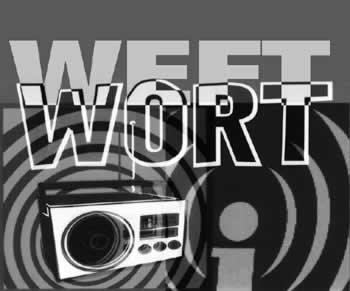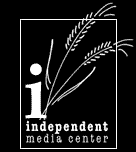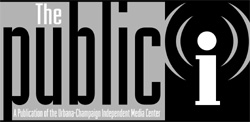|
|
|
|
|
“High Noon” Independent
Media Summit
by Robert W. McChesney
It may not have compared in terms
of sheer drama and suspense, and certainly not in terms
of violence, to the classic Gary Cooper film of the same
name. But a recent “High Noon” summit on Main Street in
Urbana, involving alternative media leaders from Urbana-Champaign
and from Madison, Wisconsin, may well prove to have been
an important milestone in the continuing evolution of
the independent media movement.
For nearly five hours on the afternoon of Saturday, February
9 at the U-C Independent Media Center, approximately two
dozen leading independent media producers from Wisconsin
and Illinois put their heads together, discussing how
to make alternative media work better in our communities.
The atmosphere at the IMC was charged and passionate at
times, particularly when the local participants debated
the amount of public affairs programming on WEFT, and
its decision to drop “Democracy Now” from the schedule
several years ago. But overall the atmosphere was extremely
collegial throughout the summit, and it may well mark
the beginning of a long-term “sister city” relationship
between the two alternative media communities.
The issues that led to this first summit were simple:
How can we get more progressive voices in our media? How
can we improve the quality of community radio broadcasting?
How can we take advantage of under-utilized resources
like public access TV channels? How can we get all of
these institutions working together with each other and
with independent media centers, in order to obtain maximum
return on our resources and maximum impact for our labors?
These are fundamental questions that progressives are
addressing all across the nation and indeed, around the
globe. At the recent World Social Forum in Porto Alegre,
Brazil, developing a better public service media was a
basic theme for the 50,000 people who gathered there.
In fact, it is now commonly understood that unless we
make progress in the area of media, it will be very difficult
to advance issues of social justice, democratic reform,
or progressive social change.
The issues are certainly crucial here in Urbana-Champaign.
Although we have the basis for a solid independent media
sector, we have a long way to go.
University of Illinois Professor Al Kagan organized the
summit because he wanted to address the limitations of
the Champaign-Urbana alternative media scene. He was motivated
specifically by his concern, following September 11 and
the subsequent permanent war on “evil-doers”, that our
local independent media were not able to accommodate the
massive need for alternative news and information. He
was impressed with how Madison Wisconsin’s community radio
station, WORT, had been able to provide its listeners
with reports from great journalists like Robert Fisk and
John Pilger and critics like Noam Chomsky. “Why can’t
we have that here?” Kagan wondered. So he invited a number
of key independent media producers from Madison to visit
Urbana and discuss how they have achieved their present
level of success in dealing with similar issues there.
The Madison contingent included Norman Stockwell, the
nationally renowned operations coordinator of WORT Community
Radio; Allen Ruff, who helps manage Rainbow Books, Madison’s
independent progressive bookstore, and who has hosted
a show called “Third World View” on WORT for 12 years;
John Hamilton, who works with the Madison Independent
Media Center and has been a producer of “In Our Backyard”,
WORT’s local news program; and John Anderson, who is working
on the new Workers Independent News Service, a radio newswire
that goes out nationally to some 300 stations.
Several local folk attended as well, including representatives
from WEFT, WILL, Urbana Public Access TV, and the Urbana-Champaign
IMC.
Each of the four visitors made presentations on what has
and has not worked in Madison. Two hours of discussion
followed, and this discussion was not simply a one-way
flow, with the sharpies from Madison lecturing the local
yokels from the prairies. The Madisonians were especially
impressed with the high caliber of the Independent Media
Center facilities on Main Street. The Madison IMC, by
comparison, operates out of the WORT offices.
Several important points emerged from the discussion.
First, in Madison the various alternative media institutions
work very closely together, sharing resources and personnel.
In addition to those mentioned above, there is the Madison
Insurgent (a monthly newspaper very similar to the UC-IMC’s
public i); a low-power pirate radio station; John Stauber
and Sheldon Rampton’s PR Watch; and The Progressive, the
90-year-old national political magazine founded by Robert
“Fighting Bob” La Follette. In addition, some of Madison’s
mainstream media, such as the weekly paper Isthmus and
the afternoon daily newspaper The Capital Times, publish
writers affiliated with the various alternative media.
There is considerable synergy between all of these media
organizations in Madison; some of the staff members at
The Progressive, for example, came out of positions at
WORT or Rainbow Books.
In short, Madison has achieved a situation where the whole
is greater than the sum of its parts, which is extremely
valuable for progressive political work in the area. As
Allen Ruff emphasized in his comments, the point of alternative
media is ultimately political, and one important measure
of media success is an increase in informed political
participation. The synergy in Madison also means that
the community attracts young people who want to do alternative
media. It was this synergy that was the most striking
feature of the summit’s briefings. This was the most important
message of the day.
Everyone agreed that Urbana needs to develop this approach
as well, and there was much discussion of the ways in
which it is already happening, such as the IMC news programming
on WEFT. Moreover, the participants agreed that it would
be valuable for indymedia workers from Madison and Urbana-Champaign
to collaborate on a regular basis. Expect to see stories
produced here end up in Madison-based media, and vice
versa.
Second, a good deal of the discussion addressed WEFT,
and its perceived paucity of public affairs programming,
particularly as compared to WORT. Stockwell described
the great crisis at WORT in the mid 90s that led to a
major shake-up. WORT now has five to six hours daily of
public affairs programming between 8 a.m. and 8 p.m..
WEFT, by comparison, has two to three hours of similar
programming during the same time period, and only one
to two hours between 6 a.m. and 6 p.m. WORT’s public affairs
programming is very popular, and cements the station in
the community. It even has a locally produced daily radio
news program. Interestingly, there is little tension between
the public affairs side of WORT and the music programmers,
who get the 9 a.m. to noon and 2 p.m. to 5 p.m. slots
every weekday, as well as all evenings, all day Saturday,
and most of Sunday.
The WEFT representatives made it clear that it would be
nearly impossible to duplicate the WORT record on public
affairs locally. WEFT has effectively “locked in” the
current strips of shows on its schedule between 6 a.m.
and 6 p.m., and to change them would be extremely difficult.
But Paul Riismandel and Kimberley Kranich, two of the
WEFT people at the summit, argued that there is in fact
plenty of room for new public affairs programming. The
bigneed, they emphasized, is for people to propose and
develop new shows.
The third point follows from the first two. A central
theme of the summit was that there are underutilized media
resources in Urbana-Champaign. Danielle Chynoweth pointed
out that there is time available for doing programming
on Urbana’s public access TV station. Kimberly Kranich
discussed the availability of slots for public affairs
programming on WILL. She also emphasized that WILL is
a far more sympathetic public broadcaster than some atthe
summit may have thought, especially those who haled from
other regions. (The author, in fact, will host a weekly
show, “Media Matters,” on WILL-AM Sundays from 1 to 2
p.m.beginning in April.) Finally, it was noted that Urbana-Champaign
is missing out on an extremely valuable source of income
by not having an alternative bookstore selling textbooks
for the University of Illinois. Rainbow Books in Madison
generates several hundred thousand dollars annually in
textbook sales. The profits from textbook sales allow
Rainbow to maintain a large facility near the university
for public talks and meetings. Imagine if we had something
like that in Urbana-Champaign!
The event concluded just before 5 p.m., when Team Madison
headed back to the Snow Belt. The consensus was that it
was a day very well spent. Virtually everyone who attended
the summit stayed for the entire event. People from various
sectors of Urbana-Champaign’s alternative media community
got to meet each other and discuss issues of mutual concern.
All of them had an opportunity to meet like-minded people
from Madison and learn from their experiences. Some history
and progress was made in the“Summit on Main Street.” Exactly
how much will be determined in the months and years to
come.
|
|
|
|






